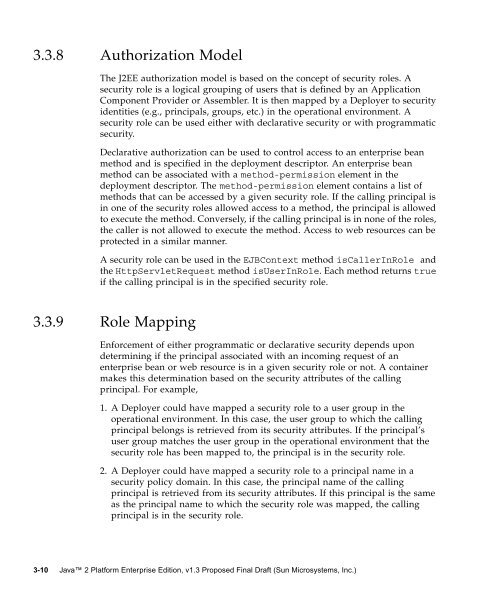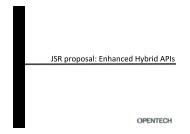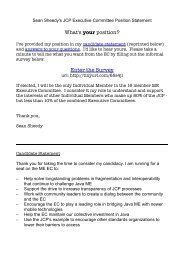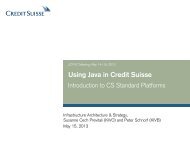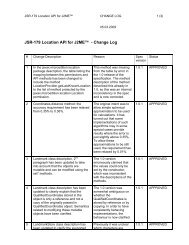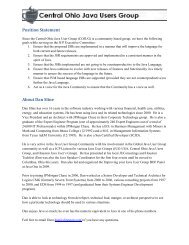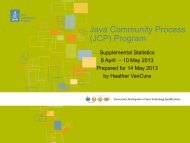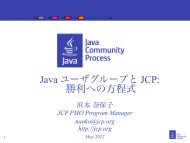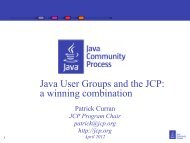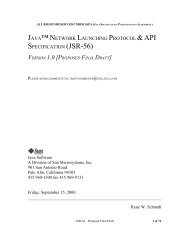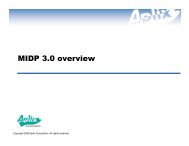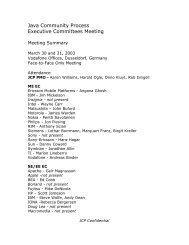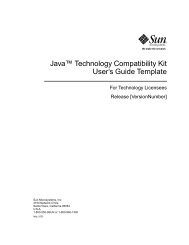JSR-000058 Java TM 2 Platform, Enterprise Edition 1.3 Specification
JSR-000058 Java TM 2 Platform, Enterprise Edition 1.3 Specification
JSR-000058 Java TM 2 Platform, Enterprise Edition 1.3 Specification
Create successful ePaper yourself
Turn your PDF publications into a flip-book with our unique Google optimized e-Paper software.
3.3.8 Authorization Model<br />
The J2EE authorization model is based on the concept of security roles. A<br />
security role is a logical grouping of users that is defined by an Application<br />
Component Provider or Assembler. It is then mapped by a Deployer to security<br />
identities (e.g., principals, groups, etc.) in the operational environment. A<br />
security role can be used either with declarative security or with programmatic<br />
security.<br />
Declarative authorization can be used to control access to an enterprise bean<br />
method and is specified in the deployment descriptor. An enterprise bean<br />
method can be associated with a method-permission element in the<br />
deployment descriptor. The method-permission element contains a list of<br />
methods that can be accessed by a given security role. If the calling principal is<br />
in one of the security roles allowed access to a method, the principal is allowed<br />
to execute the method. Conversely, if the calling principal is in none of the roles,<br />
the caller is not allowed to execute the method. Access to web resources can be<br />
protected in a similar manner.<br />
A security role can be used in the EJBContext method isCallerInRole and<br />
the HttpServletRequest method isUserInRole. Each method returns true<br />
if the calling principal is in the specified security role.<br />
3.3.9 Role Mapping<br />
Enforcement of either programmatic or declarative security depends upon<br />
determining if the principal associated with an incoming request of an<br />
enterprise bean or web resource is in a given security role or not. A container<br />
makes this determination based on the security attributes of the calling<br />
principal. For example,<br />
1. A Deployer could have mapped a security role to a user group in the<br />
operational environment. In this case, the user group to which the calling<br />
principal belongs is retrieved from its security attributes. If the principal’s<br />
user group matches the user group in the operational environment that the<br />
security role has been mapped to, the principal is in the security role.<br />
2. A Deployer could have mapped a security role to a principal name in a<br />
security policy domain. In this case, the principal name of the calling<br />
principal is retrieved from its security attributes. If this principal is the same<br />
as the principal name to which the security role was mapped, the calling<br />
principal is in the security role.<br />
3-10 <strong>Java</strong> 2 <strong>Platform</strong> <strong>Enterprise</strong> <strong>Edition</strong>, v<strong>1.3</strong> Proposed Final Draft (Sun Microsystems, Inc.)


